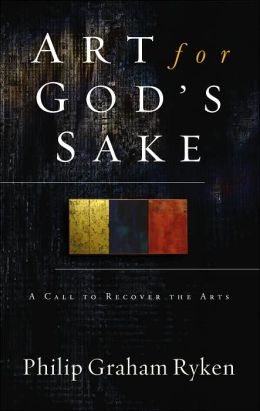
Art for God’s Sake
Philip Graham Ryken (P&R Publishing: May 2, 2006), 64 pages.A small book on a big topic is a dangerous proposition. It may show disrespect for its subject by bragging that it can be read in a short time, such as Kant in 90 minutes. (Kant in 90 minutes is not Kant at all.) On the other hand, a short book can thoughtfully introduce a profound subject worthy of further consideration; it may be a primer. Art for God’s Sake is a worthy primer; it addresses the relationship of Christian faith and art in the hope of helping Christians “recover the arts.” Philip Graham Ryken, Pastor of Tenth Presbyterian Church in Philadelphia and the author of several previous books, including Written in Stone (an insightful study of the Decalogue), has in sixty-four pages outlined a biblical view of art’s place in God’s world. Ryken is moved by the plight of the Christian artist whose calling and work is misunderstood or rejected by the church. He realizes that Christians may be suspicious of art because of their concern for idolatry and their repulsion toward much of contemporary art, which has abandoned the ideal of beauty and revels in the bizarre, the transgressive, and the outright ugly. Ryken also laments that Christians too often reduce art to utilitarian and evangelistic purposes that fail to honor art as art. Further, Christians often laud art that does not take the brokenness of life east of Eden seriously. Quite frequently, Christian art is little more than pious kitsch, which he aptly describes as “tacky artwork of poor quality that appeals to low tastes”. ~ Douglas Groothuis
Yet art should be consecrated to the glory of God, and Ryken instructs us briefly to that end. Thus he develops a sound theology of art based on the beauty of God’s creation, our status as creative beings made in God’s image (Genesis 1:26), and God’s calling on individuals to create works of art. Ryken ruminates at some length on the significance of the calling of Bezalel and Oholiab, who were inspired by the Holy Spirit to be skilled craftsmen in the construction of God’s tabernacle, his beautiful dwelling place (Exodus 31). God “called artists to make the tabernacle, and to make sure that they did it well, he equipped them with every kind of artistic talent. By doing this, God was putting the blessing of his divine approval on both the arts and the artist” (22). Moreover, these craftsmen produced “three kinds of visual art: symbolic, representative, and nonrepresentative (or abstract) art” (33), thus showing God’s endorsement of these forms. These are only two of the significant insights that Ryken draws from the tabernacle.
More generally, “the kind of art that glorifies God is good, true, and, finally, beautiful” (42). While truth and beauty are not identical, contra Keats’ “Ode to a Grecian Urn,” they belong together. Ryken notes, “The problem with some modern and postmodern art is that it seeks to offer truth at the expense of beauty. It tells the truth about ugliness and alienation, leaving out the beauty of creation and redemption” (43). On the other hand, “A good deal of so-called Christian art tends to have the opposite problem. It tries to show beauty without admitting the truth about sin, and to that extent it is false–dishonest about the tragic implications of our depravity. Think of all the bright, sentimental landscapes that portray an ideal world unaffected by the Fall…” (43). (Ryken does not name names, but he is surely thinking of Thomas Kinkade’s paintings.)
Ryken aptly summarizes this thesis in the concluding chapter, “Beautiful Savior.” “This is the Christian view of art: the artist is called and gifted by God — who loves all kinds of art; who maintains high aesthetic standards for goodness, truth, and beauty; and whose glory is art’s highest goal” (p. 53). He then concludes with a meditation on Christ’s death and resurrection in light of this thesis. The ugliness of human sin required that an all-beautiful and all-glorious God send his Son to become a disfigured and mutilated sacrifice that we might be redeemed. In this sense, “the cross screams against all the sensibilities of his divine aesthetic” (55). Yet this was the only way for redemption to be won: “Sin had brought ugliness and death into the world. In order to save his lost creation, God sent his Son right into the absurdity and alienation. There Jesus took our sin himself, dying to pay the price that justice demanded. It was such an ugly death that people had to turn away” (55-56). But God transformed this ugliness into beauty through the resurrection, in which Christ is given a glorious and triumphant body. In light of these tremendous realities, “we should devote our skill to making art for the glory of God, and for the sake of his Son — our beautiful Savior, Jesus Christ” (58).